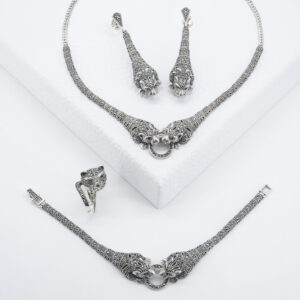The History of jewelry: From Ancient Civilizations to Modern Trends
Introduction

Jewelry has been a symbol of beauty, status, and personal expression for thousands of years. From ancient civilizations to modern fashion houses, jewelry continues to play a major role in human culture. Gold jewelry, silver jewelry, gemstone jewelry, and fine jewelry have evolved with technology, trends, and artistic creativity. Today, jewelry is not only a fashion statement but also a reflection of personal style, identity, and heritage. marcasite stone
This article explores the rich history of jewelry, how it has changed through the ages, and the modern trends shaping the industry today.
Early History of Jewelry
1: Ancient Civilizations
- Egyptians: Used gold jewelry, turquoise, and lapis lazuli to symbolize status and religion.
- Greeks and Romans: Crafted intricate designs in gold and silver jewelry, often featuring mythological themes.
- Chinese and Indian Cultures: Focused on gemstone jewelry with symbolic meanings, such as jade in China and rubies in India.
2: Medieval and Renaissance Jewelry
During the Middle Ages, jewelry was mostly worn by nobles and royalty. Gemstones and fine metals were signs of wealth and social rank. In the Renaissance era, jewelry became a form of artistic expression, with elaborate designs, enamel work, and personalized pendants.
Modern Jewelry Evolution
1: Industrial Era and Mass Production
With the invention of machinery, jewelry became more accessible to the general public. Silver jewelry and fashion jewelry gained popularity, allowing everyday people to express style and identity.
2: Contemporary Jewelry Trends
- Minimalist jewelry: Thin chains, delicate rings, and subtle bracelets.
- Statement jewelry: Oversized earrings and layered necklaces.
- Sustainable and handmade jewelry: Increasing demand for eco-friendly materials and personalized pieces.
The Role of Materials in Jewelry History
1: Gold and Silver Jewelry
Gold jewelry and silver jewelry have always been valued for beauty, durability, and status. Gold is ideal for investment, while silver is versatile for both casual and formal wear.
2: Gemstone Jewelry
Gemstones such as diamonds, emeralds, sapphires, and rubies have been used for thousands of years. Gemstone jewelry adds color, meaning, and elegance to any collection.
3: Handmade and Fashion Jewelry
Handmade jewelry allows artists to express creativity and produce unique pieces, while fashion jewelry focuses on trends and affordability.
Conclusion
The history of jewelry reflects human creativity, culture, and innovation. From ancient gold jewelry to modern gemstone and fashion jewelry, each piece tells a story. Understanding the evolution of jewelry helps us appreciate not only its beauty but also its cultural and emotional significance. Today, jewelry remains an essential part of fashion, tradition, and personal expression.

